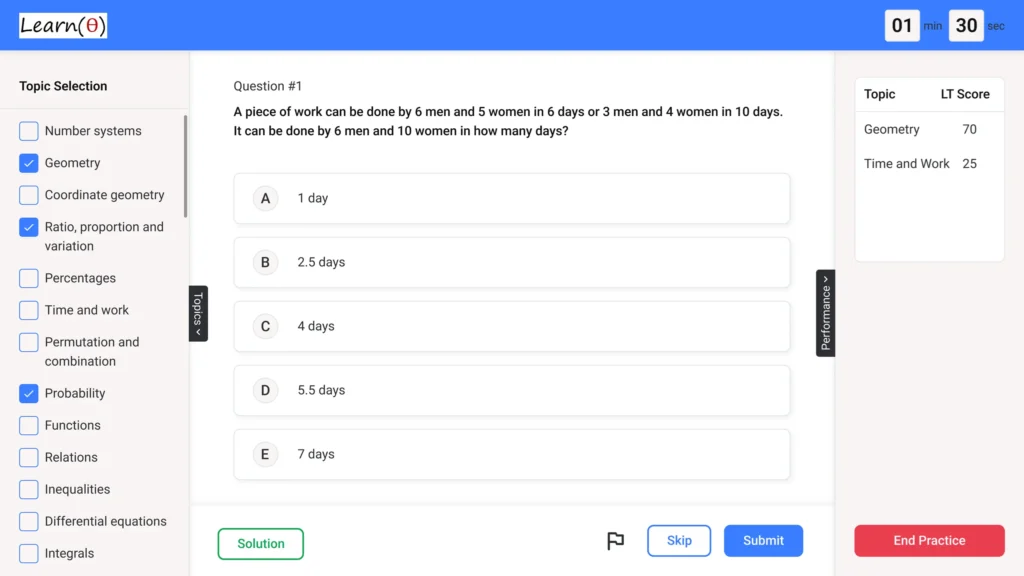Impetus – Aptitude Questions & Answers for Placement Tests
Reviewing Previous Year Questions is a good start. Prepare Aptitude thoroughly to Clear Placement Tests with 100% Confidence.
Q.1 A factory produces widgets. A worker is assigned to a task for 50 days. He can produce at most 15 widgets on any given day. If the worker produces exactly 10 widgets on any day, the following day he produces at most 5 widgets. What is the maximum number of widgets he can produce in 50 days?
Check Solution
Ans: C
To maximize production, the worker should aim to produce 15 widgets as often as possible. Let’s analyze the constraint: producing 10 widgets on a day limits production the next day. A strategy is to produce 15 widgets for as many days as possible, then alternate between days of 15 widgets, followed by days of 10 widgets, and then days of at most 5 widgets. Let’s say x days with 15 widgets. Then the condition with 10 widgets then 5 widget production reduces the production by 5 per such cycle, so the number of cycles must be minimized. Since the worker can make at most 10 widgets and then at most 5, the most widgets he can make is by setting x days with 15 widgets, which can’t lead to the constraint issue. Consider days: 15, 15, 15, 15, 15, 15, 15, 15, 15, 15, 10, 5. This is a repeating pattern. 15 widgets are made until we can no longer. If the worker produces 15 widgets on all days without any restriction, the number of widgets would be 50*15 = 750. But the condition of 10, then 5 widgets reduces the output. Try setting all to 15 until near the end. If the worker makes 15 on day 1 and 15 on day 2, and so on, and at the 48th day makes 15 widgets, and at the 49th day, he makes 10, and at the 50th day, he makes 5 widgets. 48 days with 15, 1 with 10 and 1 with 5 widgets. 48 * 15 + 10 + 5 = 720 + 15 = 735. This doesn’t work. Let’s try producing 10 and 5 widgets alternately to ensure the restriction is not met in consecutive days. So, we could make 15 for x days, then we will make 10, and then 5, which means x is the number of days and then 1 day for 10 and 1 day for 5. In this case, our total number of days is x+2. Therefore we can repeat 15 widgets, 10 and 5 as long as the worker is working. If this is repeated as 15,10,5 for 3 periods. Then the number of days would be 3+1+1=5 days. 45+10+5=60. For every 15,10,5 pattern, it makes 30 widgets for 3 days. 30/3 = 10 average widgets per day. So, 50 = 3 * 16 + 2. We can have 16 sets of 3 days with 15, 10, 5. This would produce 16*(15+10+5) = 16*30 = 480 widgets. We have 2 days remaining. Let’s set those days to 15. Then we have 480 + 15 + 15 = 510. Doesn’t make sense. Let’s prioritize 15 widgets days. x is the number of days. Let’s try 680: 15*45+10+5 = 675+10+5= 690. Close. Let the pattern be 15,15,15,15,10,5. 5 days. 60+10+5=80. 50/5 = 10 such cycles. 10 cycles*80 = 800. 15+15+15+15+10+5 for 50 days. 45*15 + 10 + 5 = 675 + 15. 15*45 days + 5 +10 = 690. We can make 15 for 45 days. Then, make 10, and 5. Total 50 days. 45*15 + 10+5= 675+15= 690. Let’s examine some options. 675: 15 for every day is an option, but it’s not optimal because it disregards the constraint. 700? Impossible. Let’s see how the total will change if we apply the constraint, consider days to be 15 for x days. 15x + 10 + 5 = 680 15x = 665, not possible. If we do 15,10, 5. The production is 30. We want to have many 15s as possible. The best is 15*48 + 10 + 5. 720+10+5. This doesn’t work. If we do 15 for 44 days and then do 10,5, then 44*15+10+5 = 660+15= 675. If we have 15*45 days then 10 and 5, we have 47 days total. then we will have 3 more days. Total: 675+10+5 = 690. Total 47. If we do 15*44+10+5 = 675. Then 2 more days to go. so 15+15 +675= 705. If we set 15,15,15,10,5. 5 * x days = 50, x = 10. so we can have 10 cycles of such. 450+ 150+ 50 = 650. 60 45*15+10+5= 690 If it makes 15, for 45 days. 10 and 5. Total = 690. Or 15 for 46 days. 10, then 5. 48. So, we have two more days. So we have to change 46*15+10+5 = 705, 2 days. 680? 680/50 = 13 15 for 45, 10 and 5. 680 If we have 680, then 15 * x + 10 + 5 = 680. 15x= 665. Not possible. 44 days = 660, 20 is remaining.
Q.2 Five friends are discussing their favorite subjects from a list: Physics, Chemistry, Biology, and Math. At least 2 friends like Physics, no more than 3 like Chemistry, exactly 1 likes Biology, and exactly 2 like Math. If three friends like exactly 2 subjects each, and two friends like exactly 3 subjects each, then how many friends like Physics?
Check Solution
Ans: D
Let’s analyze the subjects liked. Total number of subject likes = (3 friends * 2 subjects) + (2 friends * 3 subjects) = 6 + 6 = 12. We know Math is liked by 2, Biology by 1. Therefore, Physics and Chemistry collectively are liked 12 – 2 – 1 = 9 times. Let P = Number of Physics likes, C = Number of Chemistry likes. From the question, P >= 2 and C <= 3. Let's consider Physics. If P=2, then C = 7, which is not possible as C <= 3. If P = 3, then C = 6, not possible. If P = 4, then C = 5, not possible. If P = 5, then C = 4, not possible. Since three friends like exactly two subjects and two friends like exactly three, then the total number of subjects that are liked must be 3*2 + 2*3 = 12. Since Math is liked by 2 people and Biology is liked by 1, Physics and Chemistry combined have to be liked by 9 people. The minimum number of Physics likes is 2, but it cannot be determined how many friends like physics from the details provided.
Q.3 There are 27 coins. One coin is counterfeit and either heavier or lighter than the others. Using a balance scale, what is the minimum number of weighings required to guarantee finding the counterfeit coin and determining if it is heavier or lighter?
Check Solution
Ans: B
The problem is a classic balance scale puzzle. Each weighing can result in three outcomes: left side heavier, right side heavier, or balanced. The formula to solve this is 3^n >= number of items * 2, where n is the number of weighings. If n=1, 3^1>= 54; which is false. If n=2, 3^2>= 54; which is false. If n=3, 3^3=27*2+1; which is correct. The reason why * 2 is done is because the counterfeit can be either heavier or lighter.
Q.4 If Priya is taller than Rohan, then what is the average height of Rohan and Simran?
Check Solution
Ans: D
We do not know the actual heights of Rohan and Simran.
Q.5 Who plays the guitar?
Check Solution
Ans: B
Rohan practices guitar every evening. Anika loves to sing, Priya plays the piano, and Dinesh enjoys the drums.
Q.6 If Priya, Qureshi, and Rohan live in cities whose names are formed by using the letters of their names, with no letter being repeated, and Qureshi lives in a city with a name starting with the second letter of the alphabet, then who lives in a city starting with ‘R’?
Check Solution
Ans: C
Since Qureshi lives in a city starting with ‘B’ (the second alphabet), and the cities are formed from the letters of the names with no repetitions, the other two city names must be formed from Priya and Rohan. The name of Rohan’s city must start with ‘R’.
Q.7 A circle and an equilateral triangle have the same perimeter. Find the ratio of the area of the circle to the area of the triangle.
Check Solution
Ans: B
Let the perimeter be P. Radius of circle r = P/2π. Side of triangle a = P/3. Area of circle = πr^2 = π(P/2π)^2 = P^2/4π. Area of triangle = (√3/4)a^2 = (√3/4)(P/3)^2 = P^2√3/36. Ratio of areas = (P^2/4π) / (P^2√3/36) = 36/4π√3 = 9/π√3 = 9√3/3π = 3√3/π. Therefore, the ratio is 4π:3√3.
Q.8 If a – b = 2 and ab = 15, then what is the value of a^2 + b^2?
Check Solution
Ans: B
(a – b)^2 = a^2 – 2ab + b^2. Substituting the given values: 2^2 = a^2 – 2(15) + b^2. Therefore, 4 = a^2 – 30 + b^2. So, a^2 + b^2 = 34.
Q.9 Last Saturday, a local library conducted a book donation drive. Each donor received a unique five-digit code written on a sticker, on donating a book. The codes followed these rules: (i). The first digit was odd. (ii). The second digit was even. (iii). No digit was repeated in a code. (iv). The third digit was the sum of the first and second digits. A special prize was awarded to anyone holding two stickers whose codes’ first two digits, when added, resulted in a number that used only odd digits. What’s the maximum number of stickers distributed?
Check Solution
Ans: A
The first digit can be 1, 3, 5, 7, or 9 (5 options). The second digit can be 0, 2, 4, 6, or 8 (5 options). The third digit is the sum of the first two. Given the rule, the first and second digits must result in an even sum to follow rules 1, 2, 3 and 4. Possible pairs for first two digits that result in an odd sum are: (1,0), (1,2), (1,4), (1,6), (1,8), (3,0) etc. We need to calculate the number of possibilities. The first and second digits must lead to an odd number for the third digit, so the total possibilities are 5×5=25 but only a subset of them is valid. Consider the case of 1 for first digit. Then the second digit can be 0,2,4,6,8 ( 5 options). The total possible values for the third digit are 6, 7, 8, 9, 10 but with the rules we have: If first is 1 and second is 0, third is 1. (invalid: digit repetition) If first is 1 and second is 2, third is 3. (valid) If first is 1 and second is 4, third is 5. (valid) If first is 1 and second is 6, third is 7. (valid) If first is 1 and second is 8, third is 9. (valid) So there are 4 valid options for the first digit 1. Similarly, if the first digit is 3, then the second digit can be 0,2,4,6,8. 3+0 = 3 (invalid), 3+2 = 5 (valid), 3+4=7 (valid), 3+6=9 (valid), 3+8 = 11 (invalid). Thus there are 3 options. If first digit is 5, we have 5+0=5 (invalid). 5+2=7 (valid), 5+4=9 (valid). So we have 2 options. If the first digit is 7, we have 7+0=7 (invalid), 7+2=9(valid), so we have 1 option. If the first digit is 9, we have 9+0=9(invalid), we have no options. Therefore the combinations for the first 3 digits = 4+3+2+1 = 10 options. For each option, we have 2 options for the 4th digit (0-9 excluding the previous 3 digits), then 1 for the 5th. So 10x2x1 = 20. There are 4×5 = 20. The first two digits must add to only odd numbers. Consider if first digit is 1. Second digit could be 2,4,6,8. So possibilities are 4, with 2 digits. The 3rd is the sum of the first two. This leaves 7 digits. Then the fourth and fifth digits can be arranged in 7×6 ways. So number of stickers could not be more than 4x7x6 = 168.
Next: iNautix Aptitude Questions
Refer Company wise Aptitude Questions
Practice 1000s of Aptitude Questions with Answers for Quant, Reasoning & Verbal
Fastest Way to Crack Aptitude Tests – LearnTheta’s AI-Practice!

✅ All Topics at One Place

🤖 Adaptive Question Practice

📊 Progress and Insights